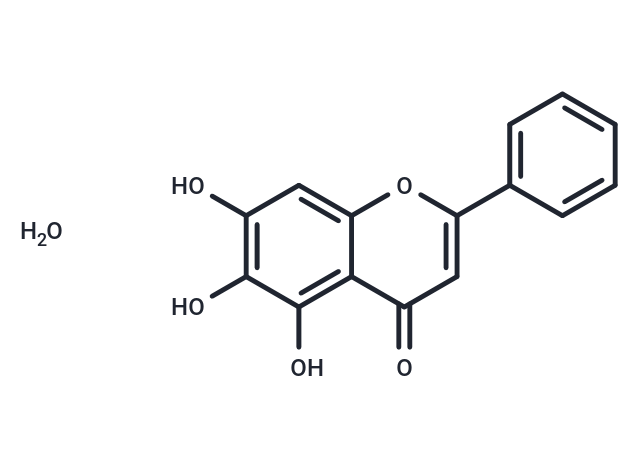Shopping Cart
Remove All Your shopping cart is currently empty
Your shopping cart is currently empty
Baicalein (5,6,7-Trihydroxyflavone) is a xanthine oxidase inhibitor.

| Pack Size | Price | USA Warehouse | Global Warehouse | Quantity |
|---|---|---|---|---|
| 100 mg | $30 | In Stock | In Stock | |
| 500 mg | $62 | In Stock | In Stock | |
| 1 g | $98 | - | In Stock | |
| 1 mL x 10 mM (in DMSO) | $31 | In Stock | In Stock |
| Description | Baicalein (5,6,7-Trihydroxyflavone) is a xanthine oxidase inhibitor. |
| Targets&IC50 | KB-3-1 cells:87.1 μM, SW48 cells:16.95 μM, MDA-MB-231 cells (24 h):89.71 µM, MDA-MB-231 cells (48 h):59.50 µM, BALB/3T3 cells:342.3 μM, HT29 cells:18.05 μM, A549 cells:13 μM, DLD-1 cells:> 20 μM, XO:3.12 mM., HUVECs:3.7 μM, 3T3-L1 cells:29.81 μM, HEK293 cells:4.4 μM, KB:62.3 μM, HepG2 cells:28.09 μM, MDA-MB-231 cells (72 h):33.61 µM |
| In vitro | Baicalein effectively inhibits T cell proliferation and cytokine secretion in response to mitogens in vitro. It has been observed that pre-treatment with baicalein markedly reduces both Con A or anti-CD3/CD28 mAb-induced cell proliferation and cytokine release at a concentration of 25 μM. Additionally, baicalein initiates NF-κB DNA binding while concurrently inhibiting nuclear thioredoxin activity. Furthermore, baicalein hampers the proliferation, migration, and invasion of MDA-MB-231 cells in both a time- and dose-dependent manner, significantly lowering SATB1 expression in these cells. It also diminishes the expression of Wnt1 and β-catenin proteins, along with the transcription of Wnt/β-catenin-regulated genes. |
| In vivo | Baicalein effectively reduces graft versus host disease induction without hindering T-cell homeostatic proliferation in mice, demonstrating its significant anti-inflammatory properties in vivo[2]. Further, in rats, baicalein administration guards against elevated heart to body weight ratios, increases in plasma brain natriuretic peptide levels, intraventricular septum thickness, and myocardial collagen volume in the left ventricle (all P<0.05, respectively). Its antifibrotic action is underscored by the reduced expression of pro-collagens I and III in the left ventricle, alongside diminished expression of 12-lipoxygenase, and lowered expression and activity of matrix metallopeptidase 9 and extracellular signal-regulated kinases, thus demonstrating baicalein's capability to inhibit cardiac fibrosis in hypertensive rats[4]. |
| Cell Research | MTT assay is conducted to evaluate the effect of baicalein on proliferation of breast cancer cells. MDA-MB-231 cells are routinely digested, collected, and then seeded in 96-well plates at a density of 8×103 cells/well. After incubation for 12-24 hours, cells are treated with 0, 20, 40, 60, 80, 100, and 120 μM baicalein according to their experimental grouping and then incubated at 37°C for 24, 48, and 72 hours[3]. |
| Synonyms | 5,6,7-Trihydroxyflavone |
| Molecular Weight | 270.24 |
| Formula | C15H10O5 |
| Cas No. | 491-67-8 |
| Smiles | O.Oc1cc2oc(cc(=O)c2c(O)c1O)-c1ccccc1 |
| Relative Density. | 1.548 g/cm3 |
| Storage | Powder: -20°C for 3 years | In solvent: -80°C for 1 year | Shipping with blue ice/Shipping at ambient temperature. | |||||||||||||||||||||||||||||||||||
| Solubility Information | DMSO: 70.7 mg/mL (261.62 mM), Sonication is recommended. | |||||||||||||||||||||||||||||||||||
| In Vivo Formulation | 10% DMSO+40% PEG300+5% Tween 80+45% Saline: 1.35 mg/mL (5 mM), Solution. Please add the solvents sequentially, clarifying the solution as much as possible before adding the next one. Dissolve by heating and/or sonication if necessary. Working solution is recommended to be prepared and used immediately. The formulation provided above is for reference purposes only. In vivo formulations may vary and should be modified based on specific experimental conditions. | |||||||||||||||||||||||||||||||||||
Solution Preparation Table | ||||||||||||||||||||||||||||||||||||
DMSO
| ||||||||||||||||||||||||||||||||||||
| Size | Quantity | Unit Price | Amount | Operation |
|---|

Copyright © 2015-2025 TargetMol Chemicals Inc. All Rights Reserved.